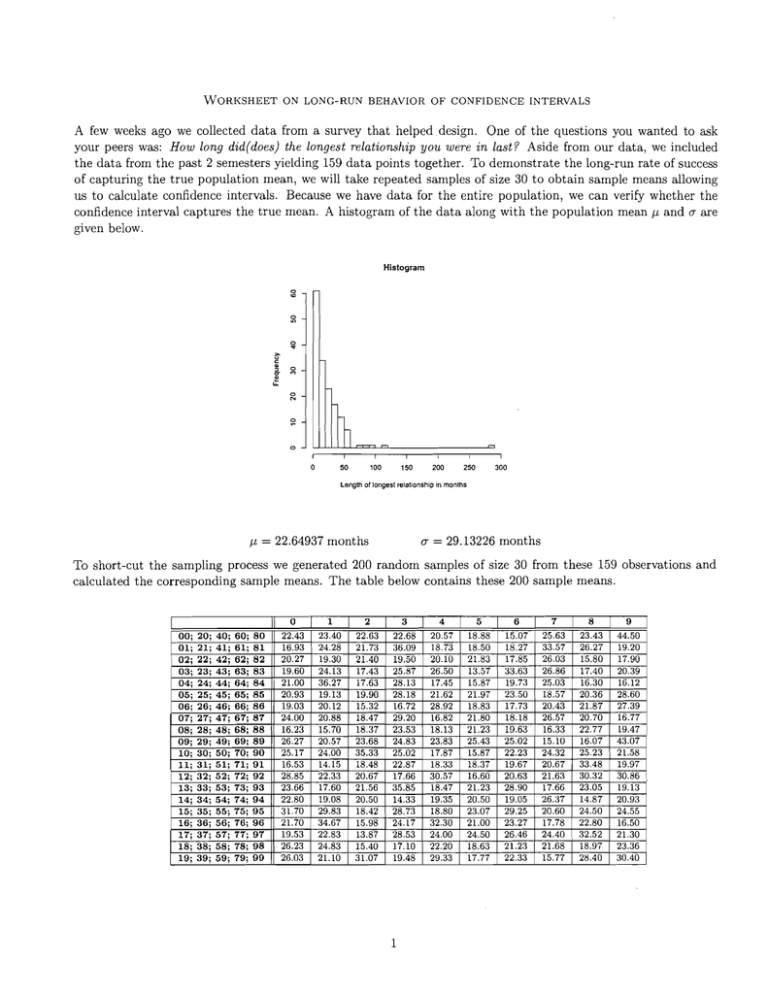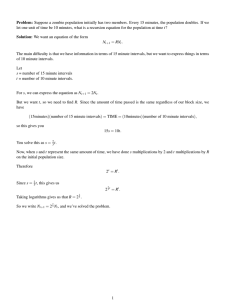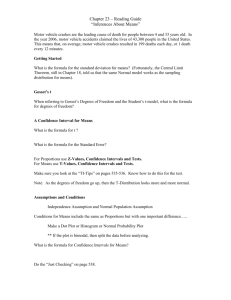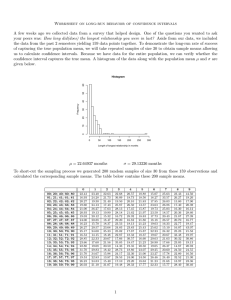Document 10746797
advertisement

WORKSHEET ON LONG-RUN BEHAVIOR OF CONFIDENCE INTERVALS
A few weeks ago we collected data from a survey that helped design. One of the questions you wanted to ask
your peers was: How long did (does) the longest relationship you were in last? Aside from our data, we included
the data from the past 2 semesters yielding 159 data points together. To demonstrate the long-run rate of success
of capturing the true population mean, we will take repeated samples of size 30 to obtain sample means allowing
us to calculate confidence intervals. Because we have data for the entire population, we can verify whether the
confidence interval captures the true mean. A histogram of the data along with the population mean J.1. and (J" are
given below.
Histogram
0
"'
:il
...
0
~
c:
""a­
...i!!
0
M
0
'"
~
o
50
100
200
150
250
300
Length of longest relationship in months
J.1.
= 22.64937 months
(J"
= 29.13226 months
To short-cut the sampling process we generated 200 random samples of size 30 from these 159 observations and
calculated the corresponding sample means. The table below contains these 200 sample means.
00;
01;
02;
03;
04;
05;
06;
01;
08;
09;
10;
11;
12;
13;
14;
15;
16;
11;
18;
19;
20;
21;
22;
23;
24;
25;
26;
21;
28;
29;
30;
31;
32;
33;
34;
35;
36;
31;
38;
39;
40;
41;
42;
43;
44;
45;
46;
41;
48;
49;
50;
51;
52;
53;
54;
55;
56;
51;
58;
59;
60;
61;
62;
63;
64;
65;
66;
61;
68;
69;
10;
11;
12;
13;
14;
15;
16;
17;
78;
19;
80
81
82
83
84
85
86
81
88
89
90
91
92
93
94
95
96
91
98
99
o
1
2
3
4
5
6
1
8
9
22.43
16.93
20.27
19.60
21.00
20.93
19.03
24.00
16.23
26.27
25.17
16.53
28.85
23.66
22.80
31.70
21.70
19.53
26.23
26.03
23.40
24.28
19.30
24.13
36.27
19.13
20.12
20.88
15.70
20.57
24.00
14.15
22.33
17.60
19.08
29.83
34.67
22.83
24.83
21.10
22.63
21.73
21.40
17.43
17.63
19.90
15.32
18.47
18.37
23.68
35.33
18.48
20.67
21.56
20.50
18.42
15.98
13.87
15.40
31.07
22.68
36.09
19.50
25.87
28.13
28.18
16.72
29.20
23.53
24.83
25.02
22.87
17.66
35.85
14.33
28.73
24.17
28.53
17.10
19.48
20.57
18.73
20.10
26.50
17.45
21.62
28.92
16.82
18.13
23.83
17.87
18.33
30.57
18.47
19.35
18.80
32.30
24.00
22.20
29.33
18.88
18.50
21.83
13.57
15.87
21.97
18.83
21.80
21.23
25.43
15.87
18.37
16.60
21.23
20.50
23.07
21.00
24.50
18.63
17.77
15.07
18.27
17.85
33.63
19.73
23.50
17.73
18.18
19.63
25.02
22.23
19.67
20.63
28.90
19.05
29.25
23.27
26.46
21.23
22.33
25.63
33.57
26.03
26.86
25.03
18.57
20.43
26.57
16.33
15.10
24.32
20.67
21.63
17.66
26.37
20.60
17.78
24.40
21.68
15.77
23.43
26.27
15.80
17.40
16.30
20.36
21.87
20.70
22.77
16.07
25.23
33.48
30.32
23.05
14.87
24.50
22.80
32.52
18.97
28.40
44.50
19.20
17.90
20.39
16.12
28.60
27.39
16.77
19.47
43.07
21.58
19.97
30.86
19.13
20.93
24.55
16.50
21.30
23.36
30.40
1
,
1. Answer the following questions, show all your work!
(a) What is the population of interest?
Q~+ 226
~~+C
(b) Using Table B obtain 3 sample means. In your own words, describe what these 3 sample means represent.
.£~
~ Y- \
\4C1
==
U~ ~I
4100 ---:-') Xz- =. \'9.02>
)
n.bleo
>---3::'
~r£~+ ~~_9' Q ~~ pL-
9f-
?~~OW-
lb~ ..s~~ t~
ut
,,~3o ~e­
&Ck
(d) Construct three 70% confidence intervals for the population mean based on your three sample means
from part (b). (Note.: The population standard deviation is 29.1~;26.) A~
I(c:-£>
~
X
~
lG1.o3 t-
n.
G~
C-l--~
0
:t ~ , / ~ IL'
bb
I
-) z.'*
29, ~~?2b
lo
I~
lco;<:>
<:)
~
(
.)
~ 104, 2~.l2J22b
=
Kia
1.04­
1~,4?fRjc2-t.570[
)
~ (\d-.l;;:L~· ~2>.l9l)
12>='
)
(d) Are the widths of your three confidence intervals the same? Explain why or why not they should be of
the same length. (This involves taking a closer look at the formula for the computation of a CI.)
(\'V
/
CU
('
et-
1
lA-
.~ ~(
(L
0TD \
: rYL =­
-3 k~oJ]:J
I
(e) Are the confidence intervals all centered at the same value? Explain why or why not they should be
centered at the same value. (Again, this involves taking a closer look at the formula for the computation
of a CI.)
No;>
-\\;~
(Q~1<'-c
~Qjk ~
D-
ef
OJ":) GcM~~ LQ 'I ,,-*"'-1,-, ,oY --lS. R,
rzLrw- &u:.: (jCl.\.l.. ['-..I.....L- j /C')~r?f~ !\'\..Q-e;_,VL_S
V~I\- f~~ Afuu..-~~
(f)
Ho~any
>-
.~O-u.-~_
of your 3 confidence intervals contained the
2
~;ue population
mean of 22.64937?
----~
(g) Write your
#
of confidence intervals containing the value 22.64937 on the chalkboard.
(h) What percentage of all the intervals on the board contains the true population mean of 22.64937?
~Gf:
A-:
l~%
[~
=
\2\
~~.
ro.~. bu-+
]Cl.%
(b~et
~\O-\J-t ~k do~ ~
(i) What percentage of intervals do you expect to contain the population mean based on what we know
about confidence intervals?
(j) Based on your first sample mean, compute a 90% confidence interval for the true average length of the
longest relationship. How does the length of the 90% confidence interval compare'to the length of your
first 70% confidence interval?
9
~ r'P~~O'" ~
~ ~~
~""' et
CL\~~
~ ~("'-oJ
~k
c
ci,~(,~O"
oJ:&OW1'~
vf
&;.s.IR-~OG-)
.~
_.n
(\)~)
we
Co +0 ~
'<)C~I~'j ~ ~
Ie
()~
Aw-e-
><
'is,
CQj)Lc~-no,-,-
~~~~
3
0
/\
t:SL
~
c
M?'-.Q..
~~
ut­
~lL--I~'~~
c:rFJ<. . ~::s.
sf
~
~(~VL
10
-t--f'\.JL lo lJ
e{
~~
¥
~~r S
r{l/d­
~l
cl.104
l~ ~
i <-,
~ '":'+
~ rzfu\lA.S:~'
V\- """ 30
.
~d
,~cP
~ ~
l 'iIU1t ~
~
'
~ t£ .
.
) cJ:&~
'~\ l~c-I.
U sp<' l~ =l~Lit 1"-81""
crt r(
G
r
'l~
CZ
l~'





